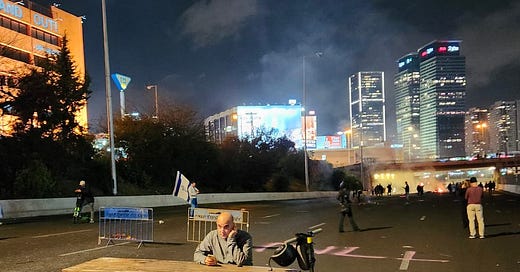

Discover more from Israel from the Inside with Daniel Gordis
Yom HaShoah (Holocaust Memorial Day) before there was a state
Holocaust Remembrance began even before statehood ... here's what it looked like

Tonight, in Israel and throughout the world, begins the observance of Yom HaShoah, technically called Yom Ha-Shoah ve-ha-Gevurah, which roughly translates as Memorial Day for Victims of the Holocaust and their Bravery.
Yom HaShoah has been part of the Jewish calendar for so long that we often forget that it wasn’t always there. It did not even follow immediately after the war. The date was officially selected by the Knesset in 1951, while the law that made the holiday “official” was passed in 1953.
The selection of the date was actually a complicated process. The rabbinate wanted the Knesset to choose the date of the Tenth of Tevet, which was already a general “day of mourning” in the traditional Jewish calendar. But the survivors, understandably, wanted a unique date—so the Knesset chose a date tied to the Warsaw Ghetto uprising.
That, itself, is significant, as the yishuv (the pre-state Jewish community in Palestine) and the citizens of early Israel struggled to honor the Holocaust victims, many of whom live today in Israel under the poverty line. In those early days of Israel, the victims were seen as weak and passive, precisely the opposite of the “new Jew” the yishuv was trying to fashion. So the Knesset chose a date tied to resistance, not to death—it fit better with the Jewish narrative Israel was seeking to transmit.
Tommy Lapid, the father of the now central Yair Lapid and a survivor of the Budapest ghetto who ultimately became a well-known Israeli journalist and successful politician, recalled years after he’d come to Israel how veteran members of the yishuv essentially accused the survivors for what they had endured. “‘Why didn’t you fight back?’ they would ask. ‘Why did you go like sheep to the slaughter?’ They were First-Class Jews who took up arms and fought, while we were Second-Class Yids whom the Germans could annihilate without encountering resistance.”1
Perhaps even more painful, those who had been born in the yishuv and come of age there often maddeningly made light of the horrific uses that Nazis had for the bodies of the murdered Jews. They knew, for example, that the Nazis had used the bodies of Jews to make soap. Lapid recalled:
At the time, there was a cook . . . who was a survivor of Auschwitz with a number tattooed in blue on his arm. The long-time staffers called him Soap, a twisted play on the famed Nazi plan to use Jewish body fat to make soap. “Hey, Soap,” they would say. “What’s for lunch today?” to which Soap would chuckle uncomfortably.
Today, those days are thankfully gone. Israel has learned to honor the victims and to deeply mourn the tragedy. As most people know, there is a national ceremony on Yom HaShoah, though perhaps the most powerful image is not the ceremony, but the moment when the country comes to a complete standstill as the air raid siren sounds (in this video, the siren itself begins at about 2:38):
But what took place between 1945 and 1951? What was there before there was Yom HaShoah? Here, in one of those old “new reels” from 1946, is a ceremony long since forgotten, which opened an entire week of mourning. Keep in mind that the high school students you see in this video were born around 1930 … those who are still alive are now in their 90s. It’s a slice of a different Israel, a young and idealistic Israel, an Israel that today seems so painfully out of reach.
So it’s worth, as we watch this video, to recall both what was, and what is, and to hope and pray that decades from now, Israel will still be remembering:
We will continue our regular schedule of posting this week with a post on the songs that have defined Israel over the decades, and later in the week, a podcast interview for paid subscribers with Ruth Calderon, one of Israel’s leading educators and a former MK, about her attempts to have the Declaration of Independence transformed into a Basic Law.
Calderon reflects with us on why she wanted the Declaration to become a Basic Law, and given what’s going on in Israel this year, what kind of Yom HaAtzma’ut (Independence Day) she thinks we’re going to have.
Wishes for a meaningful Yom HaShoah … we will resume later this week after Yom HaShoah.
Impossible Takes Longer is now available on Amazon and Barnes & Noble and at other booksellers.
Our twitter feed is here; feel free to join there, too.
This section of today’s post is taken from my book, Israel: A Concise History of a Nation Reborn, around pages 252 ff.
Subscribe to Israel from the Inside with Daniel Gordis
Israel from the Inside is for people who want to understand Israel with nuance, who believe that Israel is neither hopelessly flawed and illegitimate, nor beyond critique. If thoughtful analysis of Israel and its people interests you, welcome!
















